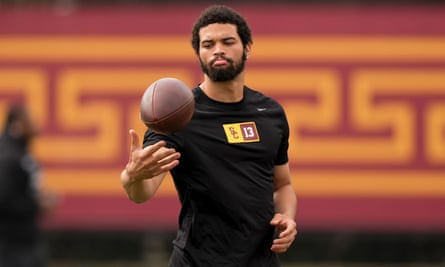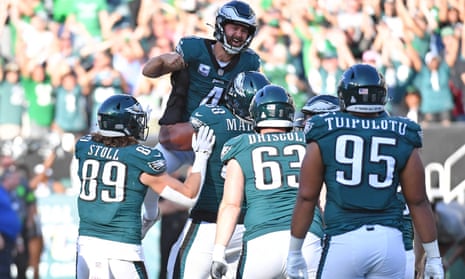The NFL will look radically different next season. The league’s owners voted on Tuesday to approve a new kickoff rule originally adopted in the XFL.
It is one of the most groundbreaking changes in league history. After slowly legislating the kickoff out of the sport, the league is embracing a new ‘hybrid’ approach that turns the kickoff into something approaching a traditional football play. No longer will kickoffs be passing moments, a chance for broadcasters to cram in a couple of commercial breaks.
Under the new rule, 21 of the 22 players on the field will line up on the returner’s side of the field. Only the kicker will be in the kicking team’s territory. The entire rule is convoluted – get ready to learn about ‘landing zones’ and ‘set up zones’. But the upshot is this: more returns, more action, fewer injuries. The rule also scraps fair catches. If the returner catches the ball in the landing zone, they must return it.
Here's a look at the official kickoff-change rule proposal. Teams could have a maximum of 2 returners. Kicking team can't move until the ball hits in the landing zone or is fielded there. No more fair catches. pic.twitter.com/LaquOHnh3d
— Jonathan Jones (@jjones9) March 20, 2024
There are few things as enjoyable as a returner popping a run. But the NFL has struggled to find a balancing act between maintaining the electric jolt of the return game while minimizing the risk of injuries. Over the past decade, the NFL has reported a three to five times higher concussion rate on kickoffs than typical offense-defense plays, largely due to the distance between the kicking and returning units and the violence of those collisions.
NFL Owners have approved the proposed new kickoff (XFL Style). Maybe we’ll see some returns when it’s implemented.
— Variety Sports Network (@variety_sports_) March 26, 2024
This is a positive to what they approved yesterday #NFLTwitter pic.twitter.com/EHfeHrIqmn
In one season in the XFL, the league reported there were zero injuries in more than 400 kickoffs that used the hybrid design. “The goal is to get the injury rate and concussion rate to be very similar to a run or pass play from scrimmage,” Jeff Miller, the NFL’s executive vice-president of communications, said on Tuesday. “Will it be a little bit higher? Will it be the same? Will it be a little bit lower?”
The knock-on consequences are profound, on and off the field. The trial run in the XFL led to some ingenious return strategies and prompted a shift in how teams built their special teams units. Returners will be now at a premium – and the mechanics on how to block and defend the new style will change, meaning the attacking and defensive units will be looking for players with different skill sets.
0 injuries in over 400 kickoffs
— Sam Schwartzstein (@schwartzsteins) October 29, 2021
93% Return Rate
It’s time all levels adopt the kickoff my team and I created https://t.co/jT0UiM5MLM pic.twitter.com/HQA10G9Tnh
2024 will be a trial run. The rule was approved on a one-year trial basis and could be shelved if the owners decide it’s a step backward. If it works as intended, though, it will be approved permanently next year, cementing the most sweeping reform to special teams play in generations.
Bringing in the new kickoff is a great change. But the league can – and should – go further. Here are a few other suggestions to consider.
Eliminate conferences in the postseason
Not since the 1980s has there been such a disparity between the two conferences. You can pin that on good fortune, fluky quarterback distribution or incompetence. The potential additions of Caleb Williams, Drake Maye, Jayden Daniels and JJ McCarthy could help address the imbalance. But for now, the NFC remains the junior varsity conference.
That’s fine during the regular season. Conferences and divisions allow the league to maintain geographical rivalries. But it’s time to switch it up for the postseason, eliminate conference standings, and seed the playoffs irrespective of conference affiliation.
A postseason should be about determining the best team – about forcing a franchise to run through a gauntlet. Given the current quarterback landscape, the AFC meets the mark and the NFC does not. The NBA toyed with the idea of moving to a model that ditched its East-West structure and rewarded the 16 best teams with playoff berths. The NFL should do the same with AFC and NFC. Decouple the playoffs from the conferences. Seed the postseason one-through-14 and give us as many great v great matchups as possible late in January.
Make quarterbacks exempt from the salary cap
There is a perverse incentive structure for quarterbacks under the current salary cap. Players want to maximize their leverage and negotiate the strongest contract possible, but if they take up too high a percentage of the cap it can kneecap their team’s ability to build a championship-caliber roster.
The reputation of quarterbacks (rightly or wrongly) is built on team success. Leaving cash on the table to help build a contender is a strand that runs through all quarterback negotiations. When a quarterback opts to leave money on the table – as Tom Brady did in New England – they’re praised for being team-first, for prioritizing winning over money, all while franchise values continue to soar.
Dak Prescott and the Cowboys are negotiating what will be the fattest contract in league history. Next up will be Brock Purdy and the 49ers. “It’s a good problem when your quarterback is one of the highest-paid guys on your team and in the league,” Niners CEO Jed York said this week when discussing Purdy’s looming contract extension. He’s correct; the Niners hit on the most valuable contract in the sport when they selected Purdy with the final pick in the 2022 draft. But now they’re in a funky situation. Does Purdy try to make up for lost time, grabbing some of the money he missed out on with his rookie deal or does he negotiate a cheaper contract to help his team maintain their star-studded roster?
NFL owners are swimming in money. The cap exists largely to stop a handful of owners indulging their own worst instincts. When the league tried to implement a secret salary cap in 2010 when there was no official number of the books, Dan Snyder and Jerry Jones couldn’t help themselves, splashing the cash behind the backs of the other 30 owners.
after newsletter promotion
Lifting the cap altogether is a non-starter. And making a carve-out for one position would be tricky to get through the players’ union – a workaround could be that one player, irrespective of position, is exempt. But teams would surely throw their money at the quarterback position because it is different. The visibility is different. Their influence is different. There’s a reason they’re already the highest-paid player on the majority of teams. Carving out a cap-free slot would allow money to be distributed elsewhere across the roster, remove the me-v-team side of negotiating and ensure continuity for players and teams at the most valuable position in the game.
Reform the draft

The draft is inherently unfair. Most regular workers aren’t forced to apply for a job before waiting to find out where they’ll be sent. And in no other workforce are the star applicants sent in descending order from the worst workplace to the best.
This offseason alone, we’ve had Caleb Williams, the presumptive No 1 overall pick in the draft, expressing his disdain for the draft structure. Earlier this week, Deion Sanders said he will encourage Shedeur Sanders, his son and the starting quarterback at Colorado, and two-way phenom Travis Hunter, to “pull an Eli” in next year’s draft, forcing through trades to their preferred destinations.
From the league’s perspective, a draft makes sense. It brings competitive balance. It allows the NFL to enforce a rookie wage scale that limits the financial exposure to busts. But we can make tweaks.
How about this: each team is allocated a rookie salary pool tied to the franchise’s performance in the previous season. Let’s say the team with the worst record in the league get a $25m pool and the Super Bowl champs get $10m. It’s then up to the teams to decide how they want to allocate their resources.
The worst team, in desperate need of a quarterback, could toss as much money as they like at the top college quarterback. But that quarterback may decide to prioritize his landing spot over cash. A star wide receiver might forgo an early payday to play with Patrick Mahomes, Jordan Love or Josh Allen. A rebuilding franchise may prefer to spread the wealth across 15 prospects rather than pouring money into the most coveted draftees.
Such a structure would maintain the Super Bowl-to-draft excitement. The Mock Draft Industrial Complex would stay at full throttle. But it would hand draftees some agency. It would not reward incompetence. It could, perhaps, prompt franchises to clean their sewage water. Just as importantly, draft night would remain compelling in its unpredictability, albeit with a fresh twist: every player would be available to every team.
The Larry David Rule
Now that Curb Your Enthusiasm is coming to an end, Larry David has moved on to a new project: eradicating kickers from the NFL. “I’m losing the goalposts,” David told the Rich Eisen Show when asked how he would change the sport. “Why are kickers, who don’t have football skills, who aren’t football players, why are they kicking a ball through goalposts to decide games? Why not just have leaping frogs to decide games?”
Eliminating field-goals – David’s key objection – is one thing. But David goes further. He wants to overhaul the point-after system. David’s idea is to remove kicked conversions. Instead, teams would elect to take the ball from the one, two or six-yard line, as they do on current two-point conversions, with different point values assigned to the distances. Convert from the one-yard line, and they score one point. From the two-yard line, it’s two points. From the six-yard line, it’s three points.
Removing field goals isn’t happening anytime soon. But escalating extra points? That’s pretty, pretty good.

Comments (…)
Sign in or create your Guardian account to join the discussion